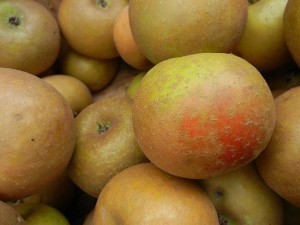Plant These Hard Cider Apple Varieties

Ashmeads Kernel apples. (Wikimedia commons photo)
Choosing the right variety can have a huge impact on the flavors of hard cider. (Read how to grow these varieties here.)
“It’s been interesting to see how much flavor you can get from just an apple,” Tim Larsen owner and cider maker of Snowdrift Cider Co., says. “I have an apple out here that fresh from the tree tastes like buttered popcorn. I’ve had one that tastes like eating nuts, like almonds.”
Larsen also is working with red-fleshed varieties from Switzerland. The hard cider made from the apples had flavors of watermelon, strawberry, and raspberry,
Ian Merwin, professor plant science emeritus, Cornell University, has about 15 hard cider apple varieties that he would encourage growers to consider. Larsen has about 35 different varieties he’s working with currently. Cider varieties are grouped into bittersweets (with tannins greater than 0.2% and malic acid less than 0.45%), bittersharps (with tannins greater than 0.2% and malic acid greater than 0.45%), sharps (with tannins less than 0.2% and malic acid greater than 0.45%), and sweet (with tannins less than 0.2% and malic acid less than 0.45%).
Here is a breakdown of Merwin and Larsen’s plantings, with some comments included:
American Varieties
- Gold Rush, “Of the modern scab-resistant varieties that are inexpensive to produce and the ones I encourage growers to consider for hard cider, Gold Rush would be at the top of my list,” Merwin says.
- Stayman’s Winesap
- Winesap
- Crimson Crisp
- Liberty
- Black Twig
- Arkansas Black
- Roxbury Russet
- Golden Russett, “It’s a heavily-russetted variety, quite brown and like sandpaper on the outside and has a very high sugar content and lots of acidity. It’s a very potent apple in a cider blend. It tends to give you aromas of citrus, grapefruit, and wine. As part of a cider blend, you get some really nice aromatic traits,” Merwin says.
- Harrison
- Newtown Pippin, also known as Albemarle Pippin, “A really popular variety for blending in hard cider,” Merwin says.
- Cox Orange Pippin, “One that does well in New England and upstate New York. It is an excellent apple for blending in a hard cider,” Merwin says.
- Ashmeads Kernel
- Wickson
- Ribston Pippin
- Northern Spy, “Makes a really excellent cider” Merwin says.
- Baldwin, “Has high sugar and it is high acid. So it really makes a good base cider,” Merwin says.
French Bittersweets
- Zabergau Reinette
- Nehou
- Muscadet de Dieppe
- Muscat de Lense
- Vilberie
- Michelin
- Medaille D’Or, “A highly-prized, highly-tannic French bittersweet,” Larsen says.
- Frequin Rouge
- Kermerien, “A really good one from Brittany,” Merwin says.
- Dabinett, “One of my favorite cider apples. It has bitter tannins and good astringency, it also has really nice, firm flesh,” Larsen says.
English Bittersweets
- Chisel Jersey
- Herefordshire Redstreak
- Sommerset Redstreak
- Yarlington Mill
- Tremlett’s Bitter, “What we call Tremlett’s Bitter in the us is not the same one that they call Tremlett’s Bitter in England because of a budwood mixup. It’s an excellent cider apple. I usually call it Geneva Turnip to distinguish it from the British one,” Merwin says.
- Harry Masters Jersey, “When it’s ripe it actually almost looks like a strawberry. It has really really dense flesh, good tannins. It’s one of those apples it changes the way you think about apples when you eat it,” Larsen says.
- Bulmer’s Norman, “Very creamy flesh bittersweet cider apple. Very good cider making apple with fuzzy white flesh, fairly juicy too,” Larsen says.
- Brown Snout
- Ellis Bitter
- Ashton Bitter
- Major
- Stembridge Jersey
- White Jersey
Bittersharps
- Porter’s Perfection, English
- Kingston Black, English, “A lot of people like to grow but it’s a difficult apple to grow but it makes a really nice cider,” says Merwin.
Sharp
- Calville Blanc d’Hiver, French
- Tom Putt, English
- Brown’s Apple, English
- Bramley’s Seedling, “An English culinary apple with good acidity,” says Larsen.
Sweet
- Belle de Boskoop, “A processing apple from Northern Europe, a good cider apple” says Merwin.
- Nova Spy
- Saint Edmund’s Pippin
What’s In A Name
Varieties of pears used to create Perry, or hard cider, have as interesting names as the flavors they create. Take Gelbmostler, Hendre Huffcap, Yellow Huffcap, Butt, Gin, Schweizer Wasserbirne, Normannischen Ciderbirne, Taynton Squash, Thielersbirne, Thorn, and Winnals Longdon to name a few.










